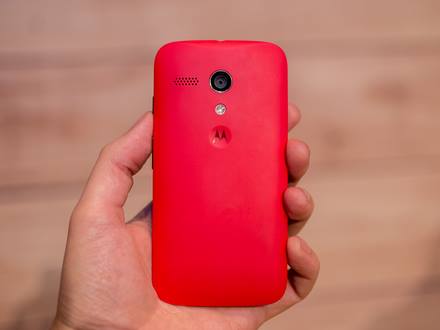Not that it will get complacent because of it, like most of the smartphones priced at around the same level do. The Motorola Moto G will bend over backwards to serve you properly and its list of features stretches far longer than most in this price range.
Key features
Quad-band GSM/GPRS/EDGE; quad-band UMTS/HSPA support
4.5″ 16M-color 720p IPS LCD capacitive touchscreen with 326ppi pixel density; Gorilla Glass
Android OS v4.3 Jelly Bean with Android 4.4 update reportedly coming as soon as January 2014
Qualcomm Snapdragon 400 chipset with quad-core 1.2GHz Cortex-A7 CPU; Adreno 305 GPU
5 MP autofocus camera with LED flash
720p video recording @ 30fps with HDR, continuous autofocus and stereo sound
1.3 MP front-facing camera
Wi-Fi b/g/n/ac; Wi-Fi Hotspot
GPS with A-GPS; GLONASS
8/16GB of built-in storage; 1GB of RAM
microUSB port with USB host
Bluetooth v4.0 LE
Standard 3.5 mm audio jack
Ambient light; accelerometer; proximity sensors
Active noise cancellation with dedicated mic
50GB of free Google Drive storage
2,070 mAh battery
Excellent speaker loudness
Main disadvantages
Limited non-expandable storage
Non user-removable battery
Questionable camera image quality, limited camera settings
It’s abundantly clear that the Motorola Moto G ticks way more boxes than a smartphone of its standing is expected to. Some might argue that it’s a luxurious strategy that can only be employed because Google will make profit off software services and not the actual hardware. Well, from a user’s perspective (and that’s the only one we care about) this point is irrelevant as all that matters is what you are getting for your money. At least on paper, the Moto G is plenty of smartphone for the price.
Some corners needed to be cut of course, but since Motorola could afford to give up immediate profits, the hardware didn’t take as bad of a hit as it normally would have. We get a base-level chipset of course, but it’s of the latest Qualcomm lineup and it should do just fine paired with a 720p screen. And since it requires less power and there’s a smaller screen here, Motorola might easily get away with the smaller battery. The unmatched body customization options of Moto X are gone too, but the (very cheaply) replaceable back covers still let you add your personal touch to the smartphone. A well rounded package indeed.
Or is it? You see, being able to sell subsidized hardware might sound like a manufacturer’s dream, but it’s not all roses. Because when you mostly rely on the software to bring in the profits, you have to make sure your services are attractive. So the microSD card slot got the axe in hope that you’ll fall back to cloud storage for most of your multimedia needs. The default skinned Android UI (or launcher, as it’s technically called) also isn’t the most functional around, so you might have to add a feature or two via third party apps.
It’s always going to be a matter of trade-offs in this price segment of the market and we now set out to find out if Motorola did the right ones. Join us on the next page for the hardware checkup.
